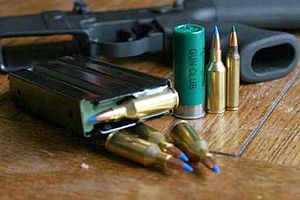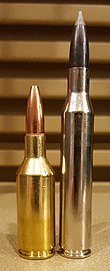
The .308 Winchester is a smokeless powder rimless bottlenecked rifle cartridge widely used for hunting, target shooting, police, military, and personal protection applications globally. It is similar, but not identical, to the 7.62×51mm NATO cartridge.

A wildcat cartridge, often shortened to wildcat, is a custom cartridge for which ammunition and/or firearms are not mass-produced. These cartridges are often created in order to optimize a certain performance characteristic of an existing commercial cartridge, or may merely be intended as novelty items.
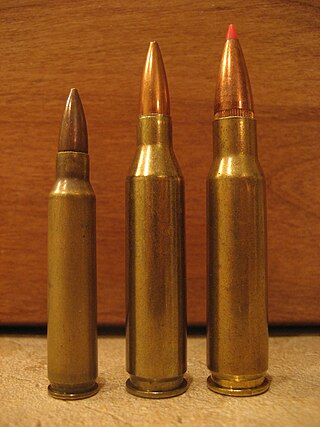
The .243 Winchester (6×52mm) is a popular sporting rifle cartridge. Developed as a versatile short action cartridge to hunt both medium game and small game alike, it "took whitetail hunting by storm" when introduced in 1955, and remains one of the most popular whitetail deer cartridges. It is also commonly used for harvesting blacktail deer, pronghorns and mule deer with heavier rounds, and is equally suited to varmint hunting with lighter rounds. The .243 is based on a necked down .308 Winchester, introduced only three years earlier. Expanding monolithic copper bullets of approximately 80 to 85 grains or traditional lead rounds of 90 to 105 grains with controlled expansion designs are best suited for hunting medium game, while lighter rounds are intended for varmints.
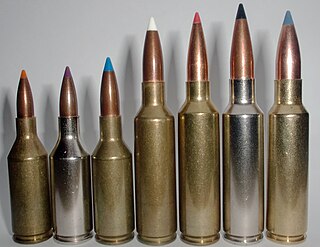
Winchester Super Short Magnum, or WSSM is a line of rebated bottlenecked centerfire short magnum cartridges introduced by the U.S. Repeating Arms Company. It is a further development of the Winchester Short Magnum concept utilizing smaller bullets, but of a still higher velocity.
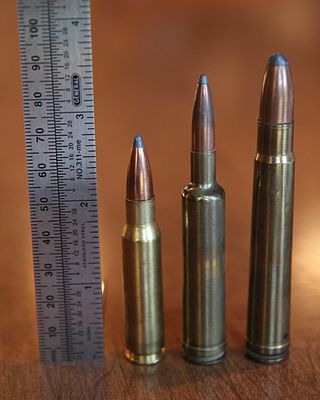
The .257 Weatherby Magnum is a .257 caliber (6.53 mm) belted bottlenecked cartridge. It is one of the original standard length magnums developed by shortening the .375 H&H Magnum case to approx. 2.5 in (64 mm). Of the cartridges developed by Roy Weatherby, the .257 Weatherby Magnum was known to have been his favorite, and the cartridge currently ranks third in Weatherby cartridge sales, after the .30-378 Weatherby Magnum and the .300 Weatherby Magnum.

The .375 H&H Magnum, also known as .375 Holland & Holland Magnum, is a medium-bore rifle cartridge introduced in 1912 by London based gunmaker Holland & Holland. The .375 H&H cartridge featured a belt to ensure the correct headspace, which otherwise might be unreliable, given the narrow shoulder of the cartridge case. The cartridge was designed to use cordite which was made in long strands – hence the tapered shape of the case, which, as a beneficial side effect also helped in smooth chambering and extraction from a rifle's breech.
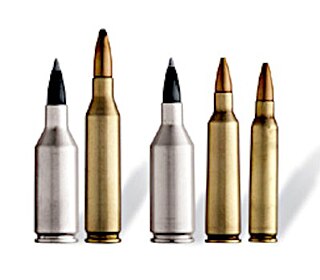
The 243 Winchester Super Short Magnum or 243 WSSM is a rifle cartridge introduced in 2003. It uses a .300 WSM case shortened and necked down to accept a .243in/6mm diameter bullet, and is a high velocity round based on ballistics design philosophies that are intended to produce a high level of efficiency. The correct name for the cartridge, as listed by the Sporting Arms and Ammunition Manufacturers' Institute (SAAMI), is 243 WSSM, without a decimal point. Winchester has discontinued the manufacture of 243 WSSM ammunition. As of the first half of 2016, Winchester/Olin did manufacture and release for sale some WSSM ammunition. The product is only manufactured periodically, often at inconsistent intervals.
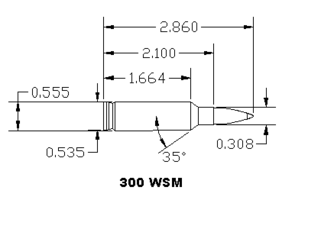
300 Winchester Short Magnum is a .30 caliber rebated rim bottlenecked centerfire short magnum cartridge that was introduced in 2001 by Winchester.

The Browning BLR is a lever-action rifle manufactured for Browning Arms Company by Miroku Firearms in Japan. It comes in many different variations and is chambered in numerous calibers from small and fast to the large Magnum rounds, and the large bore .450 Marlin.
The .264 Winchester Magnum is a belted, bottlenecked rifle cartridge. Except for the .244 H&H Magnum and .257 Weatherby Magnum, it is the smallest caliber factory cartridge derived from the 2.85 in (72 mm) Holland & Holland belted magnum case. It was introduced in the late 1950s and early 1960s with the .338 Winchester Magnum and the .458 Winchester Magnum as one of a family of short-cased 2.5 in (64 mm) belted magnum cartridges developed by Winchester based on the .375 Holland & Holland parent case. It was officially introduced to the public by Winchester in 1959. After many years of dwindling use it began enjoying a mild resurgence in popularity in the mid-2000s among long range rifle enthusiasts and reloaders due to the high ballistic coefficient of the heavier 6.5mm bullets and increasing popularity of cartridges such as 6.5mm Creedmoor, .260 Remington, 6.5 Grendel, benchrest and wildcat cartridges in 6.5mm.

The .240 Weatherby Magnum was developed in 1968 by Roy Weatherby. In the development of his own .240in/6 mm cartridge, Weatherby was significantly influenced by both the success and the limitations of the .244 H&H Magnum cartridge devised in England by his friend and colleague David Lloyd. It was the last cartridge to be designed by Roy Weatherby.

The .223 WSSM is a .224 caliber rifle cartridge created by Winchester and Browning based on a shortened version of the Winchester Short Magnum case.

The .257 Roberts, also known as .257 Bob, is a medium-powered .25 caliber rifle cartridge. It has been described as the best compromise between the low recoil and flat trajectory of smaller calibers such as the 5 mm and 6 mm, and has more energy, but is harder recoiling, similar to larger hunting calibers, such as the 7 mm and 7.62 mm.
The delta L problem refers to certain firearm chambers and the incompatibility of some ammunition made for that chamber. ΔL is a Commission Internationale Permanente (C.I.P.) geometric dimensioning and tolerancing definition for cartridge cases that are longer than the chamber they have to fit in. "Delta L" essentially means "difference in length".
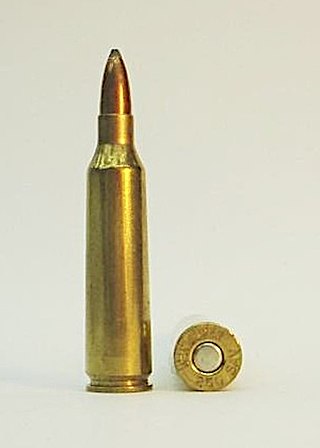
The .250-3000 Savage is a rifle cartridge created by Charles Newton in 1915. It was designed to be used in the Savage Model 99 hammerless lever action rifle. The name comes from its original manufacturer, Savage Arms, and the fact that the original load achieved a 3,000 ft/s (910 m/s) velocity with an 87 grain bullet.

The .325 Winchester Short Magnum, commonly known as the 325 WSM, is an 8mm caliber rebated rim bottlenecked centerfire short magnum medium bore cartridge. The cartridge was introduced by Winchester Ammunition in 2005.
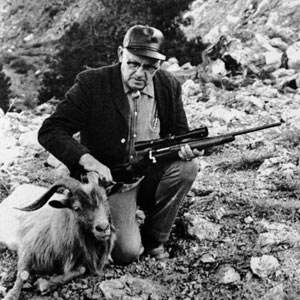
Parker Otto Ackley was an American gunsmith, barrel maker, author, columnist, and wildcat cartridge developer. The Ackley Improved family of wildcat cartridges are designed to be easily made by rechambering existing firearms, and fireforming the ammunition to decrease body taper and increase shoulder angle, resulting in a higher case capacity. Ackley improved not only standard cartridges, but also other popular wildcats, and was the first to create a .17 caliber (4.5 mm) centerfire cartridge.
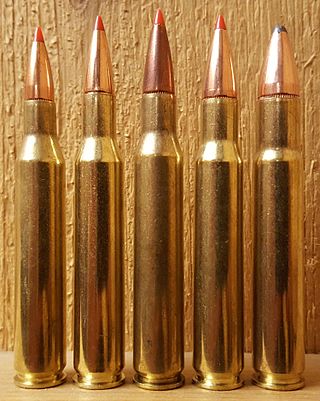
.30-06 Springfield wildcat cartridges are cartridges developed from a 30-06 Springfield "parent cartridge" through narrowing or widening the cartridge neck to fit a smaller or larger bullet in an attempt to improve performance in specific areas. Such wildcat cartridges are not standardized with recognized small arms standardization bodies like the SAAMI and the CIP.
Remington Ultra Magnum, or RUM, refers to a "family" of cartridges developed between 1999 and 2002 by Remington Arms. All of the RUM cartridges are based on the .404 Jeffery non-belted magnum cartridge. There is a long-case line, as well as a shortened version designed to fit a short rifle action. The long case is very large and provides performance that exceeds existing commercial magnums, such as the .300 Winchester Magnum and .300 Weatherby Magnum.

A varmint rifle is a small-caliber precision firearm or high-powered airgun primarily used for both varmint hunting and pest control. These tasks include killing three types of pests or nuisance animals that spread diseases or destroy crops or livestock:
